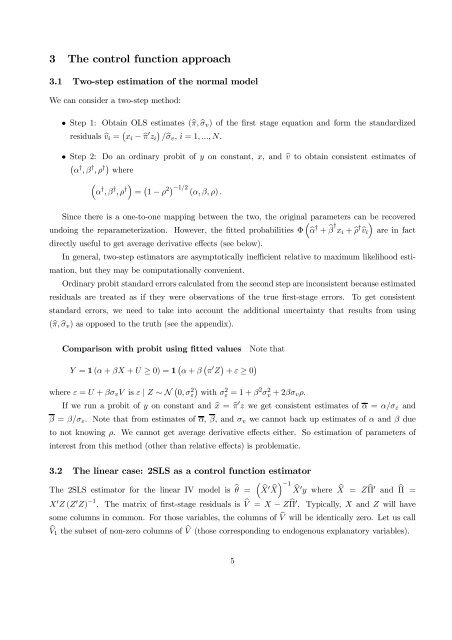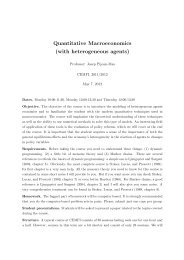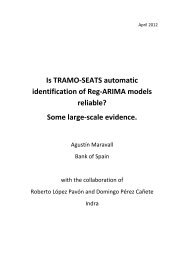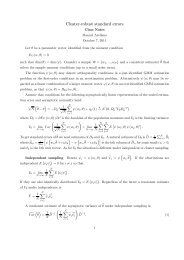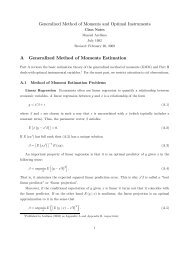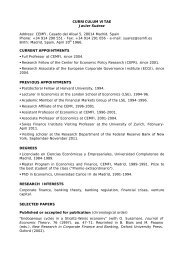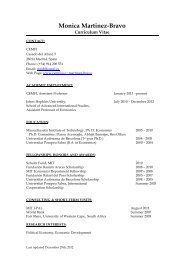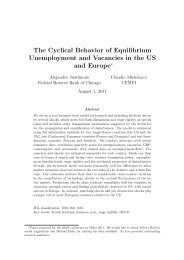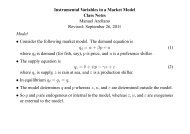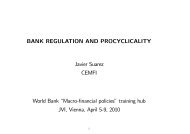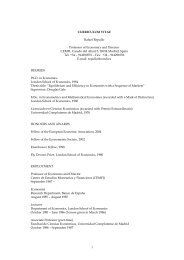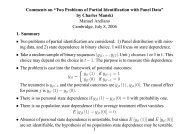Binary Models with Endogenous Explanatory Variables 1 ... - Cemfi
Binary Models with Endogenous Explanatory Variables 1 ... - Cemfi
Binary Models with Endogenous Explanatory Variables 1 ... - Cemfi
Create successful ePaper yourself
Turn your PDF publications into a flip-book with our unique Google optimized e-Paper software.
3 The control function approach<br />
3.1 Two-step estimation of the normal model<br />
We can consider a two-step method:<br />
• Step 1: Obtain OLS estimates (bπ, bσv) of the first stage equation and form the standardized<br />
residuals bvi = ¡ xi − bπ 0 ¢<br />
zi /bσv, i =1, ..., N.<br />
• Step 2: Do an ordinary probit of y on constant, x, andbv to obtain consistent estimates of<br />
¡ α † , β † , ρ † ¢ where<br />
³<br />
α † , β † , ρ †´<br />
= ¡ 1 − ρ 2¢ −1/2 (α, β, ρ) .<br />
Since there is a one-to-one mapping between the two, the original<br />
³<br />
parameters can be recovered<br />
undoing the reparameterization. However, the fitted probabilities Φ bα † + b β † xi + bρ † ´<br />
bvi are in fact<br />
directly useful to get average derivative effects (see below).<br />
In general, two-step estimators are asymptotically inefficient relative to maximum likelihood estimation,<br />
but they may be computationally convenient.<br />
Ordinary probit standard errors calculated from the second step are inconsistent because estimated<br />
residuals are treated as if they were observations of the true first-stage errors. To get consistent<br />
standard errors, we need to take into account the additional uncertainty that results from using<br />
(bπ, bσv) as opposed to the truth (see the appendix).<br />
Comparison <strong>with</strong> probit using fitted values Note that<br />
Y = 1 (α + βX + U ≥ 0) = 1 ¡ α + β ¡ π 0 Z ¢ + ε ≥ 0 ¢<br />
where ε = U + βσvV is ε | Z ∼ N ¡ 0, σ2 ¢<br />
ε <strong>with</strong> σ2 ε =1+β 2 σ2 v +2βσvρ.<br />
If we run a probit of y on constant and bx = bπ 0 z we get consistent estimates of α = α/σε and<br />
β = β/σε. Note that from estimates of α, β, andσvwe cannot back up estimates of α and β due<br />
to not knowing ρ. We cannot get average derivative effects either. So estimation of parameters of<br />
interest from this method (other than relative effects) is problematic.<br />
3.2 The linear case: 2SLS as a control function estimator<br />
The 2SLS estimator for the linear IV model is bθ =<br />
³<br />
bX 0 ´ −1<br />
bX bX 0y where bX = Z bΠ 0 and bΠ =<br />
X0Z (Z0Z) −1 . The matrix of first-stage residuals is bV = X − Z bΠ 0 . Typically, X and Z will have<br />
some columns in common. For those variables, the columns of bV will be identically zero. Let us call<br />
bV1 the subset of non-zero columns of bV (those corresponding to endogenous explanatory variables).<br />
5


